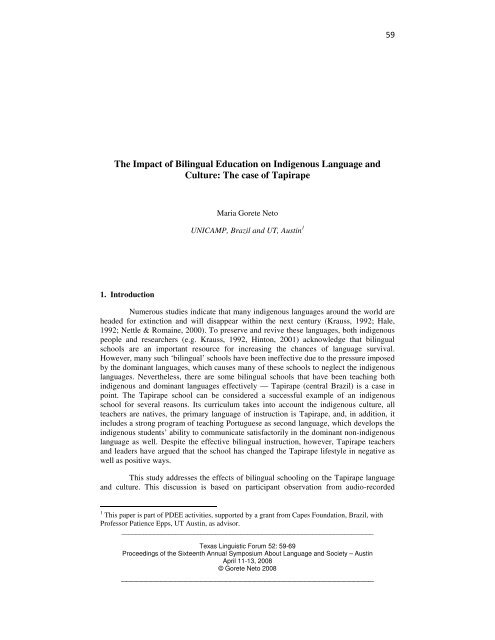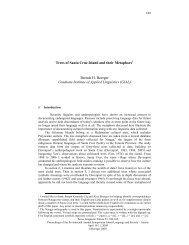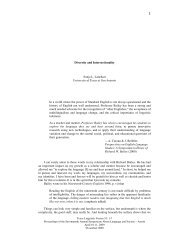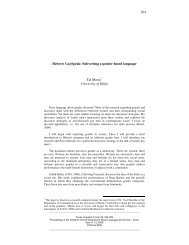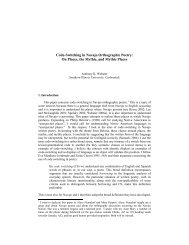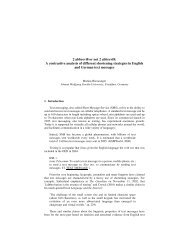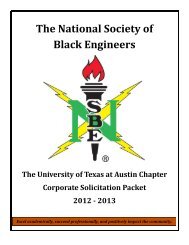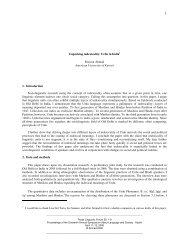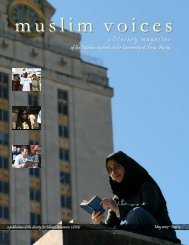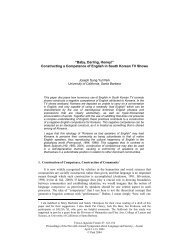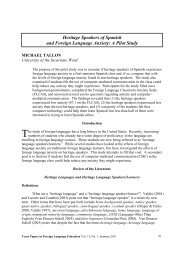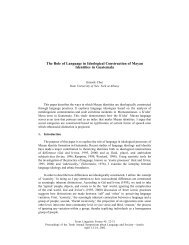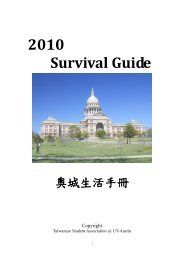The Impact of Bilingual Education on Indigenous Language and ...
The Impact of Bilingual Education on Indigenous Language and ...
The Impact of Bilingual Education on Indigenous Language and ...
Create successful ePaper yourself
Turn your PDF publications into a flip-book with our unique Google optimized e-Paper software.
<str<strong>on</strong>g>The</str<strong>on</strong>g> <str<strong>on</strong>g>Impact</str<strong>on</strong>g> <str<strong>on</strong>g>of</str<strong>on</strong>g> <str<strong>on</strong>g>Bilingual</str<strong>on</strong>g> <str<strong>on</strong>g>Educati<strong>on</strong></str<strong>on</strong>g> <strong>on</strong> <strong>Indigenous</strong> <strong>Language</strong> <strong>and</strong><br />
Culture: <str<strong>on</strong>g>The</str<strong>on</strong>g> case <str<strong>on</strong>g>of</str<strong>on</strong>g> Tapirape<br />
1. Introducti<strong>on</strong><br />
Maria Gorete Neto<br />
UNICAMP, Brazil <strong>and</strong> UT, Austin 1<br />
Numerous studies indicate that many indigenous languages around the world are<br />
headed for extincti<strong>on</strong> <strong>and</strong> will disappear within the next century (Krauss, 1992; Hale,<br />
1992; Nettle & Romaine, 2000). To preserve <strong>and</strong> revive these languages, both indigenous<br />
people <strong>and</strong> researchers (e.g. Krauss, 1992, Hint<strong>on</strong>, 2001) acknowledge that bilingual<br />
schools are an important resource for increasing the chances <str<strong>on</strong>g>of</str<strong>on</strong>g> language survival.<br />
However, many such ‘bilingual’ schools have been ineffective due to the pressure imposed<br />
by the dominant languages, which causes many <str<strong>on</strong>g>of</str<strong>on</strong>g> these schools to neglect the indigenous<br />
languages. Nevertheless, there are some bilingual schools that have been teaching both<br />
indigenous <strong>and</strong> dominant languages effectively — Tapirape (central Brazil) is a case in<br />
point. <str<strong>on</strong>g>The</str<strong>on</strong>g> Tapirape school can be c<strong>on</strong>sidered a successful example <str<strong>on</strong>g>of</str<strong>on</strong>g> an indigenous<br />
school for several reas<strong>on</strong>s. Its curriculum takes into account the indigenous culture, all<br />
teachers are natives, the primary language <str<strong>on</strong>g>of</str<strong>on</strong>g> instructi<strong>on</strong> is Tapirape, <strong>and</strong>, in additi<strong>on</strong>, it<br />
includes a str<strong>on</strong>g program <str<strong>on</strong>g>of</str<strong>on</strong>g> teaching Portuguese as sec<strong>on</strong>d language, which develops the<br />
indigenous students’ ability to communicate satisfactorily in the dominant n<strong>on</strong>-indigenous<br />
language as well. Despite the effective bilingual instructi<strong>on</strong>, however, Tapirape teachers<br />
<strong>and</strong> leaders have argued that the school has changed the Tapirape lifestyle in negative as<br />
well as positive ways.<br />
This study addresses the effects <str<strong>on</strong>g>of</str<strong>on</strong>g> bilingual schooling <strong>on</strong> the Tapirape language<br />
<strong>and</strong> culture. This discussi<strong>on</strong> is based <strong>on</strong> participant observati<strong>on</strong> from audio-recorded<br />
1<br />
This paper is part <str<strong>on</strong>g>of</str<strong>on</strong>g> PDEE activities, supported by a grant from Capes Foundati<strong>on</strong>, Brazil, with<br />
Pr<str<strong>on</strong>g>of</str<strong>on</strong>g>essor Patience Epps, UT Austin, as advisor.<br />
______________________________________________________________________<br />
Texas Linguistic Forum 52: 59-69<br />
Proceedings <str<strong>on</strong>g>of</str<strong>on</strong>g> the Sixteenth Annual Symposium About <strong>Language</strong> <strong>and</strong> Society – Austin<br />
April 11-13, 2008<br />
© Gorete Neto 2008<br />
___________________________________________________<br />
59
interviews in which teachers <strong>and</strong> leaders discuss their bilingual school <strong>and</strong> its<br />
c<strong>on</strong>sequences for the Tapirape people. <str<strong>on</strong>g>The</str<strong>on</strong>g> study dem<strong>on</strong>strates that even an effective<br />
bilingual school may introduce c<strong>on</strong>siderable complexities for an indigenous community,<br />
which may have a direct impact <strong>on</strong> cultural <strong>and</strong> linguistic maintenance. While no simple<br />
soluti<strong>on</strong>s are at h<strong>and</strong>, we propose that a c<strong>on</strong>tinuous evaluati<strong>on</strong> <strong>and</strong> <strong>on</strong>-going rec<strong>on</strong>structi<strong>on</strong><br />
<str<strong>on</strong>g>of</str<strong>on</strong>g> aspects <str<strong>on</strong>g>of</str<strong>on</strong>g> the school, directed by the community, is an essential part <str<strong>on</strong>g>of</str<strong>on</strong>g> assessing <strong>and</strong><br />
reducing these c<strong>on</strong>cerns.<br />
2. Endangered languages <strong>and</strong> bilingual schools as a resource for increasing the<br />
chances <str<strong>on</strong>g>of</str<strong>on</strong>g> language survival<br />
An <strong>on</strong>going discussi<strong>on</strong> about endangered languages <strong>and</strong> strategies for their<br />
revival <strong>and</strong> maintenance has been taking place in recent years, particularly in the field <str<strong>on</strong>g>of</str<strong>on</strong>g><br />
linguistics. Various ways to preserve <strong>and</strong> maintain those endangered languages have been<br />
suggested. We will focus <strong>on</strong> <strong>on</strong>e <str<strong>on</strong>g>of</str<strong>on</strong>g> them – educati<strong>on</strong>al programs. Krauss (1992) suggests<br />
that, for languages that are still learned by children, a significant part <str<strong>on</strong>g>of</str<strong>on</strong>g> the maintenance<br />
effort should be undertaken in school. <str<strong>on</strong>g>Educati<strong>on</strong></str<strong>on</strong>g>al programs make an important<br />
c<strong>on</strong>tributi<strong>on</strong> to reestablishing pride in the indigenous language <strong>and</strong> culture by including<br />
comp<strong>on</strong>ents <str<strong>on</strong>g>of</str<strong>on</strong>g> the native language <strong>and</strong> culture in their curriculum. Working educati<strong>on</strong>ally,<br />
culturally <strong>and</strong> politically increases the chances <str<strong>on</strong>g>of</str<strong>on</strong>g> these languages’ survival. It means<br />
involving communities in this work, as well as researchers <strong>and</strong> the government, in order to<br />
produce pedagogical materials <strong>and</strong> literature to promote the use <str<strong>on</strong>g>of</str<strong>on</strong>g> these languages; it is<br />
also necessary that governments support language planning in these communities <strong>and</strong><br />
create c<strong>on</strong>diti<strong>on</strong>s to encourage the use <str<strong>on</strong>g>of</str<strong>on</strong>g> these languages. Similarly, Hint<strong>on</strong> (2001) argues<br />
that there are different steps that can promote language revitalizati<strong>on</strong>, depending <strong>on</strong> the<br />
kind <str<strong>on</strong>g>of</str<strong>on</strong>g> language loss, <strong>and</strong> most <str<strong>on</strong>g>of</str<strong>on</strong>g> those steps involve educati<strong>on</strong>al programs. In some<br />
cases, it is necessary to develop new pedagogical programs such as c<strong>on</strong>structing a<br />
bilingual program directed toward sec<strong>on</strong>d language learning for adults as well as<br />
developing intensive courses for children, with comp<strong>on</strong>ents in the school, using the<br />
endangered language as the language <str<strong>on</strong>g>of</str<strong>on</strong>g> instructi<strong>on</strong>. Hint<strong>on</strong> identifies three types <str<strong>on</strong>g>of</str<strong>on</strong>g><br />
school-based programs for language revitalizati<strong>on</strong>, which vary in goals, limitati<strong>on</strong>s <strong>and</strong><br />
results: 1. the full-scale immersi<strong>on</strong> program, 2. teaching an endangered language as a<br />
sec<strong>on</strong>d language, <strong>and</strong> 3. the bilingual educati<strong>on</strong> program. <str<strong>on</strong>g>The</str<strong>on</strong>g> third – the focus <str<strong>on</strong>g>of</str<strong>on</strong>g> this<br />
paper - can, as the author points out, help to shape new domains <str<strong>on</strong>g>of</str<strong>on</strong>g> use for the endangered<br />
language, since its use as an instructi<strong>on</strong>al language can result in true balanced<br />
bilingualism. However, <strong>on</strong>e disadvantage is that bilingual educati<strong>on</strong> depends <strong>on</strong> good<br />
funding <strong>and</strong> governmental support to maintain schools <strong>and</strong> train teachers. Successful<br />
examples <str<strong>on</strong>g>of</str<strong>on</strong>g> school-based programs include the endangered sec<strong>on</strong>d language program in<br />
public schools in Humboldt County, California, where Tolowa, Hupa, Karuk <strong>and</strong> Yoruk<br />
are taught as sec<strong>on</strong>d languages, <strong>and</strong> the immersi<strong>on</strong> programs that have resulted in a whole<br />
generati<strong>on</strong> <str<strong>on</strong>g>of</str<strong>on</strong>g> new speakers <str<strong>on</strong>g>of</str<strong>on</strong>g> Maori <strong>and</strong> Hawaiian languages (Hint<strong>on</strong>, 2001)<br />
Despite these examples <str<strong>on</strong>g>of</str<strong>on</strong>g> successful educati<strong>on</strong>al programs, many others have<br />
failed in their goals. In Julca-Guerrero’s (2000) study <str<strong>on</strong>g>of</str<strong>on</strong>g> bilingual schools in Peruvian<br />
Quechua communities, he observes that effective bilingual teaching does not occur due to<br />
the asymmetric relati<strong>on</strong>ship between Quechua language <strong>and</strong> Spanish, since the indigenous<br />
language is not taught effectively. Many factors c<strong>on</strong>tribute to this failure. First, pressured<br />
______________________________________________________________________<br />
Texas Linguistic Forum 52: 59-69<br />
Proceedings <str<strong>on</strong>g>of</str<strong>on</strong>g> the Sixteenth Annual Symposium About <strong>Language</strong> <strong>and</strong> Society – Austin<br />
April 11-13, 2008<br />
© Gorete Neto 2008<br />
___________________________________________________<br />
60
y internati<strong>on</strong>al politics, the Peruvian government has simply imposed the bilingual school<br />
<strong>on</strong> indigenous people without engaging in a discussi<strong>on</strong> with the communities involved in<br />
the process. <str<strong>on</strong>g>The</str<strong>on</strong>g>se schools do not take into account the indigenous culture <strong>and</strong> in many<br />
cases have simply been a means for the government to obtain funds from internati<strong>on</strong>al<br />
agencies. Furthermore, politicians do not tend to promote the use <str<strong>on</strong>g>of</str<strong>on</strong>g> indigenous languages,<br />
so financial investments in bilingual schools are <str<strong>on</strong>g>of</str<strong>on</strong>g>ten not made. One c<strong>on</strong>sequence <str<strong>on</strong>g>of</str<strong>on</strong>g> this<br />
situati<strong>on</strong> is that Quechua teachers are not prepared to teach in the native language, since<br />
many do not have c<strong>on</strong>fidence in the idea <str<strong>on</strong>g>of</str<strong>on</strong>g> bilingual educati<strong>on</strong>, <strong>and</strong> most lack training.<br />
<str<strong>on</strong>g>The</str<strong>on</strong>g>re is also little written material in which Quechua instructi<strong>on</strong> can be carried out;<br />
teachers are not trained or encouraged to create these, <strong>and</strong> there are no funds to pay<br />
pr<str<strong>on</strong>g>of</str<strong>on</strong>g>essi<strong>on</strong>als to do so. Moreover, instructi<strong>on</strong> in Quechua is restricted to two hours a week<br />
or less, so that Spanish assumes the positi<strong>on</strong> <str<strong>on</strong>g>of</str<strong>on</strong>g> the instructi<strong>on</strong>al language, thus enforcing<br />
the asymmetry between Spanish <strong>and</strong> Quechua. Finally, there is a comm<strong>on</strong> belief in the<br />
Quechua communities, encouraged by the majority society, that Spanish is the best<br />
language <strong>and</strong>, in additi<strong>on</strong>, enables ec<strong>on</strong>omic ascensi<strong>on</strong>. All these factors reported by Julca-<br />
Guerrero c<strong>on</strong>tribute to unsuccessful bilingual schools, since these schools do not promote<br />
the minority language.<br />
Such problems are not restricted to bilingual schools in Peruvian Quechua<br />
communities. According to Hilaria Cruz (2008, pers<strong>on</strong>al communicati<strong>on</strong>), Chatino<br />
communities from Southern Mexico have similar problems as those experienced in Peru:<br />
lack <str<strong>on</strong>g>of</str<strong>on</strong>g> government support, low community c<strong>on</strong>fidence that their language is suitable for<br />
the school, <strong>and</strong> pr<str<strong>on</strong>g>of</str<strong>on</strong>g>essi<strong>on</strong>als who are unprepared to teach or to prepare materials in the<br />
indigenous language. Similarly, in the United States, Watahomigie <strong>and</strong> Yamamoto’s<br />
(1992) descripti<strong>on</strong> <str<strong>on</strong>g>of</str<strong>on</strong>g> the Hualapai <str<strong>on</strong>g>Bilingual</str<strong>on</strong>g>/Bicultural <str<strong>on</strong>g>Educati<strong>on</strong></str<strong>on</strong>g> Program <str<strong>on</strong>g>of</str<strong>on</strong>g> Peach<br />
Springs, Ariz<strong>on</strong>a shows that while a successful bilingual program may ultimately be<br />
possible, reaching this goal is slow <strong>and</strong> difficult work. At the beginning <str<strong>on</strong>g>of</str<strong>on</strong>g> the Hualapai<br />
program, for example, the language <str<strong>on</strong>g>of</str<strong>on</strong>g> instructi<strong>on</strong> in schools was English, <strong>and</strong> all students<br />
left school speaking English but not Hualapai. <str<strong>on</strong>g>The</str<strong>on</strong>g> idea was prevalent that indigenous<br />
languages are not complex languages <strong>and</strong> could not be taught in school. <str<strong>on</strong>g>The</str<strong>on</strong>g> researchers<br />
<strong>and</strong> the community leaders, interested in promoting Hualapai, had to fight against this<br />
point <str<strong>on</strong>g>of</str<strong>on</strong>g> view, <strong>and</strong>, now, after decades <str<strong>on</strong>g>of</str<strong>on</strong>g> work, the Hualapai community has an effective<br />
bilingual school, which encourages <strong>and</strong> promotes the use <str<strong>on</strong>g>of</str<strong>on</strong>g> both the indigenous <strong>and</strong> the<br />
n<strong>on</strong>-indigenous language. All <str<strong>on</strong>g>of</str<strong>on</strong>g> these testim<strong>on</strong>ies indicate that is not so easy to c<strong>on</strong>struct<br />
a successful educati<strong>on</strong>al program for minority languages.<br />
In Brazil, bilingual educati<strong>on</strong> programs share some similarities with the programs<br />
cited above. Many were originally imposed by missi<strong>on</strong>aries (Catholic or Protestant SIL),<br />
e.g., the Xavante, Bororo <strong>and</strong> Karaja schools (central Brazil) <strong>and</strong> the Kaingang schools<br />
(southern Brazil), to cite a few (Silva, 1998; D’Angelis, 2003). <str<strong>on</strong>g>The</str<strong>on</strong>g> main goal <str<strong>on</strong>g>of</str<strong>on</strong>g> these<br />
schools was to c<strong>on</strong>vert indigenous children to Christianity <strong>and</strong>/or to foster the translati<strong>on</strong><br />
<strong>and</strong> reading <str<strong>on</strong>g>of</str<strong>on</strong>g> the Bible in the indigenous language; in some cases indigenous children<br />
were separated from their parents <strong>and</strong> interned in a missi<strong>on</strong> school to receive both<br />
schooling <strong>and</strong> Christian doctrine. <str<strong>on</strong>g>The</str<strong>on</strong>g> indigenous language was used <strong>on</strong>ly as a language <str<strong>on</strong>g>of</str<strong>on</strong>g><br />
transiti<strong>on</strong> to Portuguese. In additi<strong>on</strong>, the model for the indigenous schools was drawn<br />
directly from n<strong>on</strong>-indigenous Brazilian schools, with the result that these indigenous<br />
schools have not taken the indigenous culture <strong>and</strong> social patterns into account. Since these<br />
______________________________________________________________________<br />
Texas Linguistic Forum 52: 59-69<br />
Proceedings <str<strong>on</strong>g>of</str<strong>on</strong>g> the Sixteenth Annual Symposium About <strong>Language</strong> <strong>and</strong> Society – Austin<br />
April 11-13, 2008<br />
© Gorete Neto 2008<br />
___________________________________________________<br />
61
schools were not in fact c<strong>on</strong>structed to attend to the needs <str<strong>on</strong>g>of</str<strong>on</strong>g> the indigenous communities,<br />
indigenous students typically leave them with no skills in reading <strong>and</strong> writing in either the<br />
indigenous language or Portuguese, even today in some cases. Currently, although there<br />
are still many missi<strong>on</strong>aries trying to persuade indigenous people to ab<strong>and</strong><strong>on</strong> their religi<strong>on</strong><br />
<strong>and</strong> culture <strong>and</strong> c<strong>on</strong>vert to Christianity, the most culturally insensitive missi<strong>on</strong> schools<br />
have become largely extinct, <strong>and</strong> many indigenous peoples have undertaken efforts to<br />
c<strong>on</strong>struct schools that work effectively for them. In this process <str<strong>on</strong>g>of</str<strong>on</strong>g> c<strong>on</strong>structi<strong>on</strong>, however,<br />
there are many obstacles <strong>and</strong> problems similar to those discussed above. Supported by<br />
Brazilian laws (particularly the C<strong>on</strong>stituti<strong>on</strong> <str<strong>on</strong>g>of</str<strong>on</strong>g> Brazil, 1988) which recognize indigenous<br />
peoples’ right to speak their languages <strong>and</strong> express their culture, there is an effort to<br />
reshape these schools to be both compatible with the indigenous culture <strong>and</strong> to help<br />
indigenous people deal with the n<strong>on</strong>-indigenous world. However, in spite <str<strong>on</strong>g>of</str<strong>on</strong>g> modern<br />
Brazilian law, the Brazilian Government has failed to financially support the indigenous<br />
schools or to c<strong>on</strong>struct linguistics policies that promote indigenous rights.<br />
Although many Brazilian indigenous communities have experienced these<br />
problems in c<strong>on</strong>structing <strong>and</strong> maintaining viable schools, there are nevertheless some<br />
indigenous communities that have been more successful. Some <str<strong>on</strong>g>of</str<strong>on</strong>g> the best examples are<br />
the Tuyuka school (northwest Brazil) <strong>and</strong> the Myky <strong>and</strong> Tapirape schools (central Brazil).<br />
<str<strong>on</strong>g>The</str<strong>on</strong>g>se schools have adopted a bilingual/bicultural curriculum, <strong>and</strong> their educati<strong>on</strong>al<br />
programs are structured according to the linguistic <strong>and</strong> cultural needs <str<strong>on</strong>g>of</str<strong>on</strong>g> the communities.<br />
Subjects such as native agricultural practices <strong>and</strong> traditi<strong>on</strong>al h<strong>and</strong>icrafts are part <str<strong>on</strong>g>of</str<strong>on</strong>g> a<br />
curriculum in which the indigenous language is the language <str<strong>on</strong>g>of</str<strong>on</strong>g> instructi<strong>on</strong>, <strong>and</strong><br />
Portuguese is taught as sec<strong>on</strong>d language. In this paper, we focus <strong>on</strong> <strong>on</strong>e <str<strong>on</strong>g>of</str<strong>on</strong>g> these<br />
communities – the Tapirape.<br />
3. <str<strong>on</strong>g>The</str<strong>on</strong>g> Tapirape people <strong>and</strong> their bilingual school<br />
<str<strong>on</strong>g>The</str<strong>on</strong>g> Tapirape people live in Mato Grosso, central Brazil. <str<strong>on</strong>g>The</str<strong>on</strong>g>y number about 670<br />
individuals, who live in several small villages (Akara’ytawa, Xapi’iekeatawa, Wiriaotawa,<br />
Majtyritawa, <strong>and</strong> the main village Tapi’itawa) in two protected areas or reservati<strong>on</strong>s<br />
(Urubu Branco <strong>and</strong> Tapirape-Karaja). <str<strong>on</strong>g>The</str<strong>on</strong>g>y speak Tapirape (<str<strong>on</strong>g>of</str<strong>on</strong>g> the Tupi-guarani family) as<br />
their mother t<strong>on</strong>gue.<br />
<str<strong>on</strong>g>The</str<strong>on</strong>g> history <str<strong>on</strong>g>of</str<strong>on</strong>g> the Tapirape school begins with the Tapirape’s fight for their<br />
traditi<strong>on</strong>al l<strong>and</strong>s. In the late 1960s, the Tapirape l<strong>and</strong>s were being invaded <strong>and</strong> deforested<br />
by n<strong>on</strong>-indigenous people. To prove that they were owners <str<strong>on</strong>g>of</str<strong>on</strong>g> the indigenous l<strong>and</strong>, the<br />
invaders produced maps <strong>and</strong> documents written in Portuguese. Up until this time, the<br />
Tapirape had not been interested in having a school. After the invasi<strong>on</strong>, however, they felt<br />
that the school could be useful for them in that it could help them underst<strong>and</strong> the<br />
Portuguese <strong>and</strong> the maps used by the invaders. <str<strong>on</strong>g>The</str<strong>on</strong>g>y directed their request for a school to<br />
some Catholic missi<strong>on</strong>aries – the “Little Sisters <str<strong>on</strong>g>of</str<strong>on</strong>g> Jesus” - who had living with them since<br />
1952. <str<strong>on</strong>g>The</str<strong>on</strong>g>se missi<strong>on</strong>aries sent the Tapirape request <strong>on</strong> to a secular couple, both teachers.<br />
This couple then came to live in the village in order to help the Tapirape found a school<br />
<strong>and</strong> to c<strong>on</strong>struct a curriculum for them. This curriculum was based <strong>on</strong> the Paulo Freire’s<br />
pedagogy, an approach to schooling founded by Freire (1967, 1968), that stresses<br />
compatibility with the local culture. At first, <strong>on</strong>ly adults attended classes, with the goal <str<strong>on</strong>g>of</str<strong>on</strong>g><br />
______________________________________________________________________<br />
Texas Linguistic Forum 52: 59-69<br />
Proceedings <str<strong>on</strong>g>of</str<strong>on</strong>g> the Sixteenth Annual Symposium About <strong>Language</strong> <strong>and</strong> Society – Austin<br />
April 11-13, 2008<br />
© Gorete Neto 2008<br />
___________________________________________________<br />
62
preparing Tapirape leaders to deal with the invaders as quickly as possible. Currently,<br />
however, the school includes both elementary <strong>and</strong> high school levels. <str<strong>on</strong>g>The</str<strong>on</strong>g> language <str<strong>on</strong>g>of</str<strong>on</strong>g><br />
instructi<strong>on</strong> is Tapirape, all teachers are Tapirape, <strong>and</strong> there are specific schedules for<br />
classes in Tapirape <strong>and</strong> in Portuguese as a sec<strong>on</strong>d language. Students leave school<br />
competent in reading <strong>and</strong> writing both Tapirape <strong>and</strong> Portuguese (Dias de Paula, 2000).<br />
Since 2006, roughly half <str<strong>on</strong>g>of</str<strong>on</strong>g> the Tapirape students who have applied to attend Brazilian<br />
universities have been accepted after passing Portuguese pr<str<strong>on</strong>g>of</str<strong>on</strong>g>iciency exams.<br />
If we compare the Tapirape school with other, less successful indigenous schools<br />
in Brazil, we can identify specific factors that c<strong>on</strong>tribute to the Tapirape success. First, the<br />
school was originally requested by the Tapirape people, rather than being initiated by n<strong>on</strong>governmental<br />
organizati<strong>on</strong>s or imposed by missi<strong>on</strong>aries, as was the case for the Xavante<br />
<strong>and</strong> others cited above. <str<strong>on</strong>g>The</str<strong>on</strong>g> Tapirape school is thus not associated with the cultural<br />
violence <str<strong>on</strong>g>of</str<strong>on</strong>g> missi<strong>on</strong>aries. Although its founding was related to the struggle over l<strong>and</strong>, we<br />
can assume that school has a political <strong>and</strong> symbolic significance for the Tapirape, since the<br />
fight for traditi<strong>on</strong>al l<strong>and</strong>s has meant the fight for Tapirape survival. Sec<strong>on</strong>d, the respectful<br />
attitudes <str<strong>on</strong>g>of</str<strong>on</strong>g> the school’s n<strong>on</strong>-Tapirape founders have been an essential part <str<strong>on</strong>g>of</str<strong>on</strong>g> its<br />
development. <str<strong>on</strong>g>The</str<strong>on</strong>g>se founders worked ‘with’ the Tapirape rather than ‘for’ them; they<br />
listened to the views <strong>and</strong> wishes <str<strong>on</strong>g>of</str<strong>on</strong>g> the Tapirape, <strong>and</strong> they respected the indigenous sense<br />
<str<strong>on</strong>g>of</str<strong>on</strong>g> time – requiring l<strong>on</strong>g deliberati<strong>on</strong> for all decisi<strong>on</strong>s - <strong>and</strong> the choices made by the<br />
Tapirape, even when these decisi<strong>on</strong>s were c<strong>on</strong>trary to the founders’ own points <str<strong>on</strong>g>of</str<strong>on</strong>g> view.<br />
Currently, too, each decisi<strong>on</strong> regarding the school is discussed by the Tapirape community<br />
in meetings that can take up to several days. <str<strong>on</strong>g>The</str<strong>on</strong>g> community decides who should be the<br />
teachers, who should be the director, how to organize the school budget, where the school<br />
should be built, what kind <str<strong>on</strong>g>of</str<strong>on</strong>g> calendar the school should have, <strong>and</strong> virtually every other<br />
issue relating to the school. An important example <str<strong>on</strong>g>of</str<strong>on</strong>g> the founders’ respect for Tapirape<br />
wishes is the following. As menti<strong>on</strong>ed above, the curriculum was first c<strong>on</strong>ceived with the<br />
reality <str<strong>on</strong>g>of</str<strong>on</strong>g> Tapirape life <strong>and</strong> culture in mind. In order to include Tapirape community<br />
activities – with the assumpti<strong>on</strong> that these are also part <str<strong>on</strong>g>of</str<strong>on</strong>g> the students’ educati<strong>on</strong> – the<br />
curriculum was originally designed to be quite flexible in order to allow students to spend<br />
more time with their families. In the beginning, for example, classes were not held every<br />
day. Although this seemed to be the best way to respect, promote <strong>and</strong> maintain indigenous<br />
life, in the 1980s, the Tapirape community – pressured by the policies <strong>and</strong> negative<br />
evaluati<strong>on</strong>s <str<strong>on</strong>g>of</str<strong>on</strong>g> the surrounding n<strong>on</strong>-indigenous society – asked the founders <str<strong>on</strong>g>of</str<strong>on</strong>g> the school<br />
for a strict, daily schedule. After a pr<str<strong>on</strong>g>of</str<strong>on</strong>g>ound discussi<strong>on</strong> within the community (Eunice<br />
Dias de Paula <strong>and</strong> Little Sisters <str<strong>on</strong>g>of</str<strong>on</strong>g> Jesus, 1999, p. c.), the school changed its schedule;<br />
since then classes have been held every day <strong>and</strong> at specific hours, as in the n<strong>on</strong>-indigenous<br />
schools.<br />
Although Tapirape bilingual educati<strong>on</strong> could be c<strong>on</strong>sidered very successful, since<br />
the community has been in charge <str<strong>on</strong>g>of</str<strong>on</strong>g> the school <strong>and</strong> the students have dem<strong>on</strong>strated<br />
competence in both the indigenous language <strong>and</strong> Portuguese, many leaders <strong>and</strong> other<br />
pers<strong>on</strong>s from the community are c<strong>on</strong>scious <str<strong>on</strong>g>of</str<strong>on</strong>g> the changes the school has brought to the<br />
indigenous lifestyle. We will present their evaluati<strong>on</strong> <str<strong>on</strong>g>of</str<strong>on</strong>g> these issues below, <strong>and</strong> discuss<br />
how schools can impact culture <strong>and</strong> language in indigenous communities. <str<strong>on</strong>g>The</str<strong>on</strong>g> data we<br />
analyze are excerpts (collected in August 2006) from recorded interviews with teachers<br />
<strong>and</strong> leaders representing all the Tapirape villages. In these interviews, 11 teachers <strong>and</strong><br />
______________________________________________________________________<br />
Texas Linguistic Forum 52: 59-69<br />
Proceedings <str<strong>on</strong>g>of</str<strong>on</strong>g> the Sixteenth Annual Symposium About <strong>Language</strong> <strong>and</strong> Society – Austin<br />
April 11-13, 2008<br />
© Gorete Neto 2008<br />
___________________________________________________<br />
63
leaders (9 men <strong>and</strong> 2 women, 30-55 years old) discuss their school <strong>and</strong> explain their<br />
expectati<strong>on</strong>s <strong>and</strong> c<strong>on</strong>cerns about it. <str<strong>on</strong>g>The</str<strong>on</strong>g> interviewees are highly involved in community<br />
life <strong>and</strong> serve important roles in their villages; their opini<strong>on</strong>s largely reflect those <str<strong>on</strong>g>of</str<strong>on</strong>g> the<br />
Tapirape community in general.<br />
3.1 Positive Aspects <str<strong>on</strong>g>of</str<strong>on</strong>g> the Tapirape <str<strong>on</strong>g>Bilingual</str<strong>on</strong>g> School<br />
This secti<strong>on</strong> presents the excerpts in which interviewees point out how the<br />
Tapirape school program has been successful in helping the Tapirape people. According to<br />
interviewees, the school has c<strong>on</strong>tributed to the aut<strong>on</strong>omy <str<strong>on</strong>g>of</str<strong>on</strong>g> the Tapirape vis-a-vis<br />
Brazilian nati<strong>on</strong>al culture. <str<strong>on</strong>g>The</str<strong>on</strong>g> Tapirape people are now better able to fight for their rights<br />
without the assistance <str<strong>on</strong>g>of</str<strong>on</strong>g> n<strong>on</strong>-indigenous agencies because they have become familiar with<br />
the n<strong>on</strong>-indigenous language (Portuguese) <strong>and</strong> culture through their bilingual school. In<br />
additi<strong>on</strong>, the school has helped them to maintain their own language <strong>and</strong> culture through<br />
instructi<strong>on</strong> in the Tapirape language, as well as in native craftsmanship <strong>and</strong> agricultural<br />
practices. <str<strong>on</strong>g>The</str<strong>on</strong>g> first extract depicts the school as an important achievement for the Tapirape<br />
people, since it has been helped them to learn the n<strong>on</strong>-indigenous language <strong>and</strong> underst<strong>and</strong><br />
Brazilian culture as well as maintain the indigenous culture <strong>and</strong> language:<br />
(1) In my pers<strong>on</strong>al opini<strong>on</strong>, the Tapirape school is a kind <str<strong>on</strong>g>of</str<strong>on</strong>g> c<strong>on</strong>quest. Our school has<br />
helped us to know things that we didn’t know before. It has taught n<strong>on</strong>indigenous<br />
knowledge <strong>and</strong> our culture too <strong>and</strong> made it str<strong>on</strong>ger. (Korira’i<br />
Tapirape, 08.19.06, male Portuguese language teacher, Akara’ytawa village vicechief)<br />
<str<strong>on</strong>g>The</str<strong>on</strong>g> speaker points out that the school allows the Tapirape to “know things that<br />
we didn’t know before” - such as Portuguese <strong>and</strong> the use <str<strong>on</strong>g>of</str<strong>on</strong>g> maps. In additi<strong>on</strong>, a main goal<br />
<str<strong>on</strong>g>of</str<strong>on</strong>g> the school is to promote <strong>and</strong> maintain the indigenous language <strong>and</strong> culture, as the<br />
following three extracts illustrate:<br />
(2) <str<strong>on</strong>g>The</str<strong>on</strong>g> most important thing is teaching in our language. If we are teaching in our<br />
language, we will not lose our culture. (Makato Tapirape, 08.21.06, female<br />
Tapirape language teacher)<br />
(3) Positive points <str<strong>on</strong>g>of</str<strong>on</strong>g> the school are related to knowing our own culture <strong>and</strong><br />
language. School really helps us in revitalizing our language <strong>and</strong> lifestyle, <strong>and</strong> in<br />
recording our culture. In additi<strong>on</strong>, school is teaching us how n<strong>on</strong>-indigenous<br />
people behave. It has helped us in the fight for our l<strong>and</strong>s because we need to write<br />
documents in Portuguese for the Brazilian authorities. (Kamoriwa’i Tapirape,<br />
08.22.06, male geography teacher <strong>and</strong> vice-chief <str<strong>on</strong>g>of</str<strong>on</strong>g> Tapi’itawa).<br />
______________________________________________________________________<br />
Texas Linguistic Forum 52: 59-69<br />
Proceedings <str<strong>on</strong>g>of</str<strong>on</strong>g> the Sixteenth Annual Symposium About <strong>Language</strong> <strong>and</strong> Society – Austin<br />
April 11-13, 2008<br />
© Gorete Neto 2008<br />
___________________________________________________<br />
64
(4) School is important for us because we are surrounded by n<strong>on</strong>-indigenous people.<br />
So, the school is beneficial for us: it teaches writing <strong>and</strong> reading, <strong>and</strong> documents<br />
our language by keeping a written record <str<strong>on</strong>g>of</str<strong>on</strong>g> it. Before the school, we didn’t keep<br />
a record <str<strong>on</strong>g>of</str<strong>on</strong>g> the Tapirape language. We kept it <strong>on</strong>ly in our minds, in our memories.<br />
Nowadays, we are producing materials in our language. Also, school helps us<br />
dialogue with n<strong>on</strong>-indigenous people. We need to underst<strong>and</strong> them just as we<br />
need to write documents in Portuguese. (Ieremy’i Tapirape, 08.23.06, male<br />
Tapirape language teacher)<br />
Excerpts 2, 3 <strong>and</strong> 4 illustrate that knowledge about the n<strong>on</strong>-indigenous culture<br />
<strong>and</strong> language is c<strong>on</strong>sidered crucial in the fight for indigenous rights. Being surrounded by<br />
n<strong>on</strong>-indigenous people was a determining factor in founding the school. In additi<strong>on</strong>, as the<br />
interviewees argue, school created a new tool for Tapirape people – a way to record the<br />
language for future generati<strong>on</strong>s, as pointed out in (4). On <strong>on</strong>e h<strong>and</strong>, the interviewee claims<br />
that indigenous people have their own ways to save <strong>and</strong> protect their languages. <str<strong>on</strong>g>The</str<strong>on</strong>g>y do<br />
not need school to do it. On the other h<strong>and</strong>, the n<strong>on</strong>-indigenous presence forces indigenous<br />
people to search for extra ways to protect themselves. In this case, the extra way is the<br />
school which provides an additi<strong>on</strong>al mechanism to store the language <strong>and</strong> culture. Clearly<br />
the school is not an indigenous artifact. It was imposed by the violence <str<strong>on</strong>g>of</str<strong>on</strong>g> the c<strong>on</strong>tact with<br />
n<strong>on</strong>-indigenous people <strong>and</strong> it has been appropriated by the Tapirape people. This<br />
appropriati<strong>on</strong> within the Tapirape community entails giving meaning to <strong>and</strong> creating<br />
functi<strong>on</strong>s for that ‘foreign artifact’.<br />
<str<strong>on</strong>g>The</str<strong>on</strong>g> process <str<strong>on</strong>g>of</str<strong>on</strong>g> appropriati<strong>on</strong> <str<strong>on</strong>g>of</str<strong>on</strong>g> the school is related to indigenous aut<strong>on</strong>omy as<br />
well. As excerpt 5 below expresses, another goal <str<strong>on</strong>g>of</str<strong>on</strong>g> the school is to improve <strong>and</strong> promote<br />
indigenous aut<strong>on</strong>omy relative to n<strong>on</strong>-indigenous people:<br />
(5) <str<strong>on</strong>g>The</str<strong>on</strong>g> young people are being prepared by the school. In the future, we will not<br />
need n<strong>on</strong>-indigenous advisors anymore. We are improving our aut<strong>on</strong>omy. In this<br />
way school is a kind <str<strong>on</strong>g>of</str<strong>on</strong>g> tool. (Inamoreo Tapirape, 08.23.06, male geography<br />
teacher)<br />
Aut<strong>on</strong>omy - the right <str<strong>on</strong>g>of</str<strong>on</strong>g> a community to govern itself <strong>and</strong> to organize its own<br />
activities - can be fostered by the school, although the process may be a l<strong>on</strong>g <strong>on</strong>e. But<br />
because the school is a n<strong>on</strong>-indigenous inventi<strong>on</strong>, it must be shaped <strong>and</strong> directed by the<br />
indigenous people in order to ensure that it does indeed promote their aut<strong>on</strong>omy. <str<strong>on</strong>g>The</str<strong>on</strong>g><br />
Tapirape people have been shaping their school from the beginning; however, full<br />
aut<strong>on</strong>omy requires the training <str<strong>on</strong>g>of</str<strong>on</strong>g> young indigenous people to manage their school.<br />
3.2 Negative Aspects <str<strong>on</strong>g>of</str<strong>on</strong>g> the Tapirape <str<strong>on</strong>g>Bilingual</str<strong>on</strong>g> School<br />
Although Tapirape interviewees point out positive aspects <str<strong>on</strong>g>of</str<strong>on</strong>g> their school, most<br />
also recognize that the school has introduced pr<str<strong>on</strong>g>of</str<strong>on</strong>g>ound changes to their lives, <str<strong>on</strong>g>of</str<strong>on</strong>g> which<br />
some are unanticipated <strong>and</strong> unwelcome. Some interviewees evaluate these changes as<br />
negative aspects <str<strong>on</strong>g>of</str<strong>on</strong>g> the school. One example is the amount <str<strong>on</strong>g>of</str<strong>on</strong>g> time that the school occupies<br />
in the students’ daily lives, as described in excerpts 6 <strong>and</strong> 7:<br />
______________________________________________________________________<br />
Texas Linguistic Forum 52: 59-69<br />
Proceedings <str<strong>on</strong>g>of</str<strong>on</strong>g> the Sixteenth Annual Symposium About <strong>Language</strong> <strong>and</strong> Society – Austin<br />
April 11-13, 2008<br />
© Gorete Neto 2008<br />
___________________________________________________<br />
65
(6) Since the school’s foundati<strong>on</strong>, children have not been participating in traditi<strong>on</strong>al<br />
life. <str<strong>on</strong>g>The</str<strong>on</strong>g>y do not go to the fields anymore <strong>and</strong> they d<strong>on</strong>’t have time to spend with<br />
their families. Nowadays, parents encourage their kids <strong>on</strong>ly to go to school.<br />
(Korira’i Tapirape, cited above)<br />
(7) Before the school, we used to go to the fields or to the river to fish <strong>and</strong> hunt with<br />
our children. Nowadays it is really difficult to do these kinds <str<strong>on</strong>g>of</str<strong>on</strong>g> things because<br />
children start school when they are 7 years old, <strong>and</strong> this does not allow them go<br />
out <str<strong>on</strong>g>of</str<strong>on</strong>g> the village with their parents. This is a negative aspect <str<strong>on</strong>g>of</str<strong>on</strong>g> school.<br />
(Kamoriwa’i, cited above)<br />
According to these interviewees, the bilingual school has reduced the traditi<strong>on</strong>al<br />
spaces in which young people can learn about Tapirape culture. <str<strong>on</strong>g>The</str<strong>on</strong>g> students have less<br />
time to spend with their parents because they are required to go to school every day. Some<br />
<str<strong>on</strong>g>of</str<strong>on</strong>g> them do not learn how to cultivate traditi<strong>on</strong>al crops, <strong>and</strong> they receive less instructi<strong>on</strong><br />
according to traditi<strong>on</strong>al, h<strong>and</strong>s-<strong>on</strong> Tapirape pedagogy, which is based <strong>on</strong> observati<strong>on</strong> <strong>and</strong><br />
repetiti<strong>on</strong>. When there was no school in the village, children used to learn in public spaces<br />
like the fields, the forest, the river beach or the family home, but this now occurs less<br />
frequently. <str<strong>on</strong>g>The</str<strong>on</strong>g> interviewees emphasize that there is an indigenous educati<strong>on</strong> that it is not<br />
associated with schooling. <str<strong>on</strong>g>The</str<strong>on</strong>g> school is not able to teach many <str<strong>on</strong>g>of</str<strong>on</strong>g> those skills that are<br />
acquired in a h<strong>and</strong>s-<strong>on</strong> setting; <strong>on</strong>ly the time spent with the extended family provides the<br />
opportunity for apprenticeship. This time with the family also allows for the enrichment <str<strong>on</strong>g>of</str<strong>on</strong>g><br />
native language usage <strong>and</strong> learning. Although school has been appropriated by the<br />
Tapirape people, many Tapirape feel that it is still a n<strong>on</strong>-indigenous creati<strong>on</strong> that should<br />
not usurp the traditi<strong>on</strong>al indigenous learning spaces.<br />
<str<strong>on</strong>g>The</str<strong>on</strong>g> following passage emphasizes the ideas presented in excerpt 6 <strong>and</strong> 7 above<br />
<strong>and</strong> also adds that the school is stealing time not <strong>on</strong>ly from the children, but also from the<br />
adults who work in the school. According to this interviewee, teachers are spending a<br />
great deal <str<strong>on</strong>g>of</str<strong>on</strong>g> time in school, <strong>and</strong> do not have time to spend with their families or to<br />
cultivate traditi<strong>on</strong>al crops – implying poor use <str<strong>on</strong>g>of</str<strong>on</strong>g> Tapirape l<strong>and</strong>:<br />
(8) School functi<strong>on</strong>s to teach n<strong>on</strong>-indigenous culture, but not our culture. <str<strong>on</strong>g>The</str<strong>on</strong>g> school<br />
doesn’t work well in this case: we have our l<strong>and</strong> <strong>and</strong> nobody uses it. Teachers<br />
d<strong>on</strong>’t have time to cultivate the fields. N<strong>on</strong>-indigenous people are bullying us,<br />
saying we are lazy people. In additi<strong>on</strong>, school doesn’t allow children to fish or<br />
spend time with their parents. As far as n<strong>on</strong>-indigenous culture is c<strong>on</strong>cerned<br />
school is good; we are learning about it. But our culture, it will be destroyed stepby-step,<br />
slowly. (Xywaeri Tapirape, 08.22.06, Tapi’itawa chief)<br />
This interviewee points out a further impact <str<strong>on</strong>g>of</str<strong>on</strong>g> the school, relating to the n<strong>on</strong>indigenous<br />
evaluati<strong>on</strong> <str<strong>on</strong>g>of</str<strong>on</strong>g> the way the Tapirape are using their l<strong>and</strong>. It brings up a c<strong>on</strong>flict<br />
experienced by many indigenous communities. On <strong>on</strong>e h<strong>and</strong>, they are obliged to adopt a<br />
school – a n<strong>on</strong>-indigenous artifact - <strong>and</strong> if they do not, they are labeled “uncivilized”. On<br />
the other h<strong>and</strong>, if the school occupies too much <str<strong>on</strong>g>of</str<strong>on</strong>g> the time needed for traditi<strong>on</strong>al<br />
activities, they are criticized for being lazy. This interviewee is also c<strong>on</strong>cerned about the<br />
______________________________________________________________________<br />
Texas Linguistic Forum 52: 59-69<br />
Proceedings <str<strong>on</strong>g>of</str<strong>on</strong>g> the Sixteenth Annual Symposium About <strong>Language</strong> <strong>and</strong> Society – Austin<br />
April 11-13, 2008<br />
© Gorete Neto 2008<br />
___________________________________________________<br />
66
Tapirape culture <strong>and</strong> believes that it will be slowly lost. A related issue involves the<br />
maintenance <str<strong>on</strong>g>of</str<strong>on</strong>g> the native language, as illustrated by excerpt 9:<br />
(9) We have been mixing our language with Portuguese. We didn’t use to do this but,<br />
nowadays, there are a lot <str<strong>on</strong>g>of</str<strong>on</strong>g> words that we d<strong>on</strong>’t have in our language. Children<br />
are hearing these words in Portuguese, in school <strong>and</strong> other places, <strong>and</strong> using them<br />
in the Tapirape language. (Ieremy’i Tapirape, cited above)<br />
Despite the emphasis <strong>on</strong> teaching in Tapirape, Portuguese has gained prestige in<br />
the community. <str<strong>on</strong>g>The</str<strong>on</strong>g>re has been an increase <str<strong>on</strong>g>of</str<strong>on</strong>g> code switching. Although this has not yet<br />
affected the vitality <str<strong>on</strong>g>of</str<strong>on</strong>g> the indigenous language, interviewees argue that it threatens their<br />
language, <strong>and</strong> they have identified the school as the culprit <str<strong>on</strong>g>of</str<strong>on</strong>g> this phenomen<strong>on</strong>. <str<strong>on</strong>g>The</str<strong>on</strong>g><br />
interviewees are aware that their language is in c<strong>on</strong>flict with a majority language <strong>and</strong> that<br />
school has an important role in c<strong>on</strong>trolling or not c<strong>on</strong>trolling the code-switching that is<br />
taking place.<br />
<str<strong>on</strong>g>The</str<strong>on</strong>g> negative evaluati<strong>on</strong>s c<strong>on</strong>sidered here focus <strong>on</strong> the changes to the traditi<strong>on</strong>al<br />
lifestyle that have been brought about by bilingual schooling. But although the Tapirape<br />
leaders point out these problems, this does not imply that they do not want a school in the<br />
village. <str<strong>on</strong>g>The</str<strong>on</strong>g>ir c<strong>on</strong>cerns simply illustrate the c<strong>on</strong>flicts inherent in the school as a place<br />
where two different worlds are in c<strong>on</strong>tact – the indigenous <strong>and</strong> the n<strong>on</strong>-indigenous.<br />
4. Tapirape evaluati<strong>on</strong> as indicati<strong>on</strong> <str<strong>on</strong>g>of</str<strong>on</strong>g> multiple identities <strong>and</strong> representati<strong>on</strong>s<br />
<str<strong>on</strong>g>The</str<strong>on</strong>g> evaluati<strong>on</strong>s cited above reveal the “antag<strong>on</strong>istic representati<strong>on</strong>s”<br />
(Woodward, 2000) with which the Tapirape people view their school <strong>and</strong> its effects <strong>on</strong> the<br />
community. <str<strong>on</strong>g>The</str<strong>on</strong>g> positive <strong>and</strong> negative points <str<strong>on</strong>g>of</str<strong>on</strong>g> view suggest that the process <str<strong>on</strong>g>of</str<strong>on</strong>g><br />
c<strong>on</strong>structing bilingual schooling is complex <strong>and</strong> multifaceted. As a n<strong>on</strong>-indigenous<br />
instituti<strong>on</strong>, a school must be appropriated by the indigenous people it serves as well as rec<strong>on</strong>structed<br />
c<strong>on</strong>tinuously in order to be truly effective; however, c<strong>on</strong>flicting priorities <strong>and</strong><br />
interests are an unavoidable part <str<strong>on</strong>g>of</str<strong>on</strong>g> the process. <str<strong>on</strong>g>The</str<strong>on</strong>g> positive <strong>and</strong> negative evaluati<strong>on</strong>s <str<strong>on</strong>g>of</str<strong>on</strong>g><br />
the interviewees come both from the process <str<strong>on</strong>g>of</str<strong>on</strong>g> c<strong>on</strong>structing or shaping the school itself as<br />
well as from the c<strong>on</strong>structi<strong>on</strong> <str<strong>on</strong>g>of</str<strong>on</strong>g> its meaning within the community. Meaning is<br />
c<strong>on</strong>structed from a set <str<strong>on</strong>g>of</str<strong>on</strong>g> representati<strong>on</strong>s (Woodward, 2000), <strong>and</strong> can itself be c<strong>on</strong>sidered a<br />
representati<strong>on</strong>, but these representati<strong>on</strong>s are not homogeneous within the community or<br />
even within individuals, as illustrated by the positive <strong>and</strong> negative evaluati<strong>on</strong>s <str<strong>on</strong>g>of</str<strong>on</strong>g> the<br />
Tapirape school presented here.<br />
<str<strong>on</strong>g>The</str<strong>on</strong>g>se c<strong>on</strong>flicting evaluati<strong>on</strong>s can be understood to reflect c<strong>on</strong>flicting <strong>and</strong><br />
antag<strong>on</strong>istic aspects <str<strong>on</strong>g>of</str<strong>on</strong>g> Tapirape identity. On <strong>on</strong>e h<strong>and</strong>, those interviewed are in favor <str<strong>on</strong>g>of</str<strong>on</strong>g><br />
the Tapirape school because it helps them preserve their native culture <strong>and</strong> language, as<br />
well as providing a means to learn the n<strong>on</strong>-indigenous language, to underst<strong>and</strong> Brazilian<br />
<strong>and</strong> world cultures, <strong>and</strong> to assist them in their fight for their rights. On the other h<strong>and</strong>, they<br />
are against the school because it threatens their culture by introducing Portuguese <strong>and</strong> by<br />
taking time away from the family’s educati<strong>on</strong> <str<strong>on</strong>g>of</str<strong>on</strong>g> their children. <str<strong>on</strong>g>The</str<strong>on</strong>g>se different points <str<strong>on</strong>g>of</str<strong>on</strong>g><br />
______________________________________________________________________<br />
Texas Linguistic Forum 52: 59-69<br />
Proceedings <str<strong>on</strong>g>of</str<strong>on</strong>g> the Sixteenth Annual Symposium About <strong>Language</strong> <strong>and</strong> Society – Austin<br />
April 11-13, 2008<br />
© Gorete Neto 2008<br />
___________________________________________________<br />
67
view do not necessarily mean that the Tapirape people are c<strong>on</strong>fused about their school, but<br />
rather indicate the different facets <str<strong>on</strong>g>of</str<strong>on</strong>g> their identity as a people. This is best understood if<br />
we keep in mind that identities are fluid <strong>and</strong> are c<strong>on</strong>structed in c<strong>on</strong>trast <strong>and</strong> in oppositi<strong>on</strong><br />
to another individual or group (Hall, 1992); for the Tapirape, this opposing group is that <str<strong>on</strong>g>of</str<strong>on</strong>g><br />
n<strong>on</strong>-indigenous people. When thinking <strong>and</strong> talking about the school, those interviewed are<br />
dealing with an artifact invented by the n<strong>on</strong>-indigenous world <strong>and</strong> imposed <strong>on</strong> the<br />
Tapirape but which they have appropriated – thus generating c<strong>on</strong>flicting positi<strong>on</strong>s about<br />
the same topic.<br />
<str<strong>on</strong>g>The</str<strong>on</strong>g> bilingual school c<strong>on</strong>tributes to the c<strong>on</strong>structi<strong>on</strong> <str<strong>on</strong>g>of</str<strong>on</strong>g> these antag<strong>on</strong>istic <strong>and</strong><br />
c<strong>on</strong>flicting identities because it is a hybrid space (Bhabha, 2003) where two different<br />
cultures are in c<strong>on</strong>tact. Spaces for indigenous <strong>and</strong> n<strong>on</strong>-indigenous culture are c<strong>on</strong>stantly<br />
negotiated, <strong>and</strong> thus c<strong>on</strong>flict <strong>and</strong> antag<strong>on</strong>ism are a part <str<strong>on</strong>g>of</str<strong>on</strong>g> this hybrid <strong>and</strong> fluid scenery.<br />
Antag<strong>on</strong>ism <strong>and</strong> c<strong>on</strong>flict cannot be evaluated as correct or incorrect, but rather as a natural<br />
part <str<strong>on</strong>g>of</str<strong>on</strong>g> the hybrid model, <strong>and</strong> as a reflecti<strong>on</strong> <str<strong>on</strong>g>of</str<strong>on</strong>g> different aspects <str<strong>on</strong>g>of</str<strong>on</strong>g> the situati<strong>on</strong>. <str<strong>on</strong>g>The</str<strong>on</strong>g>re is<br />
thus no unique or fixed soluti<strong>on</strong> for the problems presented by those interviewed here.<br />
However, hybridism <strong>and</strong> fluidity also imply room for flexibility <strong>and</strong> change, which as we<br />
have seen here are crucial ingredients for the success <str<strong>on</strong>g>of</str<strong>on</strong>g> a bilingual school like that <str<strong>on</strong>g>of</str<strong>on</strong>g> the<br />
Tapirape. Hybridism <strong>and</strong> fluidity suggest that every decisi<strong>on</strong> need not be fixed forever,<br />
<strong>and</strong> can instead be changed to best suit the needs <strong>and</strong> interests <str<strong>on</strong>g>of</str<strong>on</strong>g> the community.<br />
5. C<strong>on</strong>clusi<strong>on</strong><br />
In the c<strong>on</strong>text <str<strong>on</strong>g>of</str<strong>on</strong>g> the struggle to preserve endangered languages, the Tapirape case<br />
provides an important illustrati<strong>on</strong> <str<strong>on</strong>g>of</str<strong>on</strong>g> a successful bilingual educati<strong>on</strong> program. However,<br />
as this study shows, even a successful school is likely to bring complicati<strong>on</strong>s for the<br />
community. On <strong>on</strong>e h<strong>and</strong>, the access to Portuguese <strong>and</strong> the familiarity with the n<strong>on</strong>indigenous<br />
culture, facilitated by the school, have c<strong>on</strong>tributed to the ability <str<strong>on</strong>g>of</str<strong>on</strong>g> the Tapirape<br />
people to fight for their rights <strong>and</strong> to retain their aut<strong>on</strong>omy in relati<strong>on</strong> to Brazilian nati<strong>on</strong>al<br />
society; in additi<strong>on</strong>, the school has helped them to maintain their own language <strong>and</strong> culture<br />
through instructi<strong>on</strong> in the Tapirape language, as well as through the teaching <str<strong>on</strong>g>of</str<strong>on</strong>g> traditi<strong>on</strong>al<br />
skills <strong>and</strong> agricultural practices. But <strong>on</strong> the other h<strong>and</strong>, the school has occupied traditi<strong>on</strong>al<br />
spaces <str<strong>on</strong>g>of</str<strong>on</strong>g> apprenticeship by reducing the time in which young people can acquire cultural<br />
<strong>and</strong> linguistic skills in the traditi<strong>on</strong>al way, through interacti<strong>on</strong> with their extended families.<br />
Furthermore, the school has c<strong>on</strong>tributed to the increase <str<strong>on</strong>g>of</str<strong>on</strong>g> code-switching by teaching the<br />
Portuguese language, which some community members feel is a threat to the maintenance<br />
<str<strong>on</strong>g>of</str<strong>on</strong>g> Tapirape. All these issues indicate that bilingual schooling may initiate pr<str<strong>on</strong>g>of</str<strong>on</strong>g>ound social<br />
changes, while at the same time meeting certain needs <str<strong>on</strong>g>of</str<strong>on</strong>g> peoples like the Tapirape. <str<strong>on</strong>g>The</str<strong>on</strong>g><br />
anguish <strong>and</strong> c<strong>on</strong>flict that these changes may cause are linked to the hybrid, fluid nature <str<strong>on</strong>g>of</str<strong>on</strong>g><br />
the bilingual school, as a space where two different worlds are in c<strong>on</strong>tact.<br />
However, while hybridism <strong>and</strong> fluidity may cause c<strong>on</strong>flict, they also permit<br />
mobility <strong>and</strong> flexibility. <str<strong>on</strong>g>The</str<strong>on</strong>g>se are essential features <str<strong>on</strong>g>of</str<strong>on</strong>g> an indigenous school, allowing a<br />
c<strong>on</strong>tinuous shaping <str<strong>on</strong>g>of</str<strong>on</strong>g> the school, particularly by the indigenous people themselves. <str<strong>on</strong>g>The</str<strong>on</strong>g><br />
problems raised by the Tapirape interviewees can in principle be resolved if the Tapirape<br />
community recognizes that its decisi<strong>on</strong>s are not fixed <strong>and</strong> can be modified. For example,<br />
the strict schedule <str<strong>on</strong>g>of</str<strong>on</strong>g> the school – which they themselves chose, but which is causing<br />
______________________________________________________________________<br />
Texas Linguistic Forum 52: 59-69<br />
Proceedings <str<strong>on</strong>g>of</str<strong>on</strong>g> the Sixteenth Annual Symposium About <strong>Language</strong> <strong>and</strong> Society – Austin<br />
April 11-13, 2008<br />
© Gorete Neto 2008<br />
___________________________________________________<br />
68
problems – can be changed if the community decides to do so, allowing more time for<br />
young people to spend with their families. In c<strong>on</strong>clusi<strong>on</strong>, the hybrid <strong>and</strong> fluid <str<strong>on</strong>g>of</str<strong>on</strong>g> the<br />
indigenous school can itself facilitate the <strong>on</strong>going evaluati<strong>on</strong> <strong>and</strong> rec<strong>on</strong>structi<strong>on</strong> <str<strong>on</strong>g>of</str<strong>on</strong>g> the<br />
educati<strong>on</strong>al program, a c<strong>on</strong>tinuous process <str<strong>on</strong>g>of</str<strong>on</strong>g> shaping it to meet the needs <str<strong>on</strong>g>of</str<strong>on</strong>g> the<br />
communities.<br />
References<br />
Bhabha, H. (2003) <str<strong>on</strong>g>The</str<strong>on</strong>g> locati<strong>on</strong> <str<strong>on</strong>g>of</str<strong>on</strong>g> culture. L<strong>on</strong>d<strong>on</strong>, New York: Routledge.<br />
Crystal, D. (2000) Why we should care?. In Crystal, D., <strong>Language</strong> Death (pp. 27-77).<br />
Cambridge University Press.<br />
D’Angelis, W. (2003) A escola entre os Kaingang. Retrieved <strong>on</strong> February 3 rd , 2008, from<br />
http://www.portalkaingang.org/index_educ_I_II_c<strong>on</strong>t_1.htm#.<br />
Dias de Paula, E. (2001) Os Tapirape e a escrita: indícios de uma relação singular,<br />
Dissertação de mestrado, UFG, Goiânia.<br />
Freire, P. (1967) Educação como prática de liberdade. São Paulo: Paz e terra.<br />
_______ (1968) Pedagogia do oprimido. São Paulo: Paz e terra.<br />
Hale, Ken (1992) On endangered languages <strong>and</strong> the safeguarding <str<strong>on</strong>g>of</str<strong>on</strong>g> diversity. <strong>Language</strong>,<br />
Volume 68, number 1, 1-3.<br />
Hall, S. (1992) A identidade cultural na pós-modernidade. RJ: DP&A.<br />
Hint<strong>on</strong>, L. (2001) <strong>Language</strong> Revitalizati<strong>on</strong>: An Overview. In Hint<strong>on</strong>, L., <str<strong>on</strong>g>The</str<strong>on</strong>g> Green Book<br />
<str<strong>on</strong>g>of</str<strong>on</strong>g> <strong>Language</strong> Revitalizati<strong>on</strong> in Practice (pp. 3-18). Academic Press.<br />
Instituto Sócio-ambiental (2008) Formatura da 2ª turma da Escola Tuyuka c<strong>on</strong>solida<br />
c<strong>on</strong>quistas da educação escolar indígena. Retrieved <strong>on</strong> February 1 st , 2008, from<br />
http://www.socioambiental.org/nsa/detalhe?id=2459<br />
Julca-Guerrero, F. (2000) Uso de las lenguas quechua y castellano en procesos de<br />
educaci<strong>on</strong> bilingue intercultural, Tesis de Maestria en Educaci<strong>on</strong> Intercultural<br />
Bilingue, PROEIB Andes-Universidad Mayor de San Sim<strong>on</strong>.<br />
Krauss, Michael (1992) <str<strong>on</strong>g>The</str<strong>on</strong>g> world’s languages in crisis. <strong>Language</strong>, Volume 68, number 1,<br />
4-10.<br />
Nettle, Daniel & Romaine, Suzanne (2000) A world <str<strong>on</strong>g>of</str<strong>on</strong>g> diversity. In Nettle, D. & Romaine,<br />
S. (eds), Vanishing voices: <str<strong>on</strong>g>The</str<strong>on</strong>g> Extincti<strong>on</strong> <str<strong>on</strong>g>of</str<strong>on</strong>g> the World’s <strong>Language</strong>s (pp. 26-49).<br />
Oxford University Press.<br />
Silva, Teodorico Fern<strong>and</strong>es (1998) Novas terras, novos céus: a educação escolar entre os<br />
Xavante de Sangradouro (1970-1980), Revista de Educação Pública, Edição Nº<br />
12: Julho/Dezembro de 1998, UFMT. Retrieved <strong>on</strong> February 2 nd , 2008, from<br />
http://www.ufmt.br/revista/arquivo/rev12/novas_terras.html.<br />
Watahomigie, L. & Yamamoto, A. (1992) Local reacti<strong>on</strong>s to perceived language decline.<br />
<strong>Language</strong>, Volume 68, number 1, 10-17.<br />
Woodward, K. (2000) Identidade e diferença: uma introdução teórica e c<strong>on</strong>ceitual. In<br />
Silva, T. T. (org.), Hall, S. <strong>and</strong> Woodward, K. (eds.) Identidade e diferençaa: a<br />
perspectiva dos estudos culturais (pp. 7-72). RJ: Vozes.<br />
Maria Gorete Neto<br />
State University <str<strong>on</strong>g>of</str<strong>on</strong>g> Campinas, (Unicamp), Brazil<br />
mariagorete_neto@yahoo.com.br<br />
______________________________________________________________________<br />
Texas Linguistic Forum 52: 59-69<br />
Proceedings <str<strong>on</strong>g>of</str<strong>on</strong>g> the Sixteenth Annual Symposium About <strong>Language</strong> <strong>and</strong> Society – Austin<br />
April 11-13, 2008<br />
© Gorete Neto 2008<br />
___________________________________________________<br />
69


